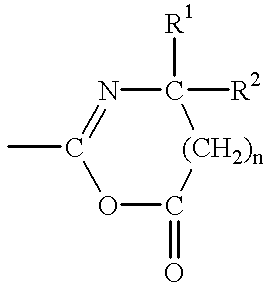Method for cell selection utilizing azlactone-functional supports
a technology of azlactone and azlactone, which is applied in the field of cell selection utilizing azlactonefunctional supports, can solve the problems of effectively destroying the patient's immune system and his bone marrow, and achieve the effects of improving purities and separation yields, high purity, and high purities
- Summary
- Abstract
- Description
- Claims
- Application Information
AI Technical Summary
Benefits of technology
Problems solved by technology
Method used
Image
Examples
example 1
Evaluation of Nonspecific Binding with Ficolled Buffy Coat
Crosslinked supports were prepared according to the teachings of U.S. Pat. No. 5,403,902, by reverse-phase suspension polymerization, using the polymeric stabilizer of Example 24E of that reference. Methylenebisacrylamide (MBA) was used as crosslinker, and comonomers used were dimethylacrylamide (DMAm), acrylamide (Am), vinyldimethylazlactone (VDM), or N-acryloyl-2-methylalanine (sodium salt) (AMA). These particulate supports were elutriated to remove small particles, then packed into the Ceprate LC column for evaluation. Each column was challenged with a minimum of 50.times.10.sup.6 whole cells of ficolled buffy coat, derived from fresh whole blood; the flow-through fractions were collected. Whole cell counts, for both lymphocytes and monocytes, were measured by fluorescence-activated cell sorting (FACS) and compared to those of the starting sample. Table 1 lists supports evaluated, whole cell recoveries, and nonspecific bin...
example 2
Evaluation of Nonspecific Binding from Mobilized Peripheral Blood
The best performing supports from Example 1, as well as support 1f, were evaluated as in Example 1 except that the challenge was mobilized peripheral blood to which the anti-CD34+ antibody had been added prior to addition to the column. Results are listed in Table 2.
This example also illustrates that it is possible to find polymer backbones that exhibit equivalent or lower nonspecific binding as compared to the prior art.
example 3
Azlactone / Dimethylacrylamide Supports
Particulate supports were prepared from MBA, VDM, and DMAm by reverse phase suspension polymerizations according to Process II of U.S. Pat. No. 5,403,902. In these experiments, total weight of monomers was 20 g. The MBA and DMAm monomers were dissolved in a mixture of methanol (30 ml) and water (70 ml). After dissolution, sodium persulfate (0.5 g) was added and allowed to dissolve. This solution was then added to a stirring solution, under nitrogen, of VDM, toluene (132 ml), heptane (243 ml), and stabilizer (0.33 g) pre-equilibrated to 35.degree. C. The nitrogen purge was continued for 5 minutes, then tetramethylethylenediamine (TMEDA, 0.5 ml) was added to initiate the polymerization. Polymerization was continued for 2 hours, the product was collected by filtration, washed with acetone, elutriated using methanol as liquid phase to remove particles smaller than 100 microns in diameter, and dried under vacuum to constant weight. Avidin coupling: Av...
PUM
| Property | Measurement | Unit |
|---|---|---|
| Fraction | aaaaa | aaaaa |
| Fraction | aaaaa | aaaaa |
| Fraction | aaaaa | aaaaa |
Abstract
Description
Claims
Application Information
 Login to View More
Login to View More - R&D
- Intellectual Property
- Life Sciences
- Materials
- Tech Scout
- Unparalleled Data Quality
- Higher Quality Content
- 60% Fewer Hallucinations
Browse by: Latest US Patents, China's latest patents, Technical Efficacy Thesaurus, Application Domain, Technology Topic, Popular Technical Reports.
© 2025 PatSnap. All rights reserved.Legal|Privacy policy|Modern Slavery Act Transparency Statement|Sitemap|About US| Contact US: help@patsnap.com

